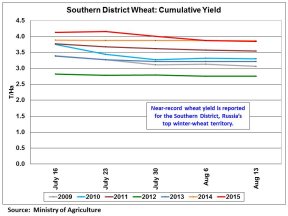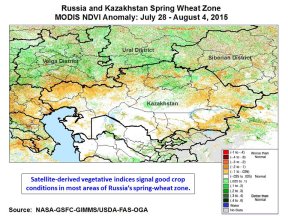Russia 2015/16 Wheat: Second Consecutive Bumper Crop
USDA estimates Russia wheat production for 2015/16 at 60.0 million metric tons, surpassing last year's crop by 0.9 million tons. Harvest reports from the Ministry of Agriculture cite record or near-record yield in the Southern and North Caucasus Districts, and near-average yield in the Central District despite severe fall drought and remarkably poor establishment conditions for the region's winter wheat. Current prospects are favorable for spring wheat in the Siberian, Volga, and Ural Districts.
Based on data from Rosstat (the State Statistical Committee of Russia), USDA estimates that the final sown area for 2015/16 winter wheat in Russia, not including Crimea, increased by 10.0 percent from last year, from 11.88 to 13.06 million hectares. Most of the increase occurred in the Central District, where area increased from 2.68 to 3.42 million hectares, the highest level in at least 20 years. Spring wheat area for Russia increased by 0.37 million hectares, to 13.54 million, partly in response to high winter-wheat losses in the Central and southern Volga Districts and subsequent replanting with spring wheat. The share of Russian winter grains destroyed by the combination of fall drought and winter frost is reported at 10.0 percent this year, compared to 2.4 percent last year and the 5-year average of 9.5 percent.
 Winter-wheat harvest was essentially complete by mid-August, with data from the Ministry of Agriculture indicating outstanding yield in the Southern and North Caucasus Districts, which together account for about half of Russia’s winter wheat area this year. Cumulative yield declined as the harvest campaign advanced from south to north, but overall yield reported for the Southern District is only 2 percent below last year’s record. Yield data also show a remarkable spring rebound for wheat in the Central District. Winter-wheat conditions were extremely poor in the Central District and in parts of the neighboring Volga Valley when the crops broke dormancy and resumed vegetative growth in early April. Excellent spring weather benefited wheat in the Central District and, with harvest about two-thirds complete, near-average yield is reported despite the bleak early-spring prospects. Spring weather was somewhat less favorable for winter wheat in the southern Volga District, and the reported winter wheat yield is 8 percent below average with harvest nearly complete. The Volga District accounts for about 20 percent of Russia’s winter wheat area; 40 percent of Volga wheat is winter wheat. Winter-wheat harvest was essentially complete by mid-August, with data from the Ministry of Agriculture indicating outstanding yield in the Southern and North Caucasus Districts, which together account for about half of Russia’s winter wheat area this year. Cumulative yield declined as the harvest campaign advanced from south to north, but overall yield reported for the Southern District is only 2 percent below last year’s record. Yield data also show a remarkable spring rebound for wheat in the Central District. Winter-wheat conditions were extremely poor in the Central District and in parts of the neighboring Volga Valley when the crops broke dormancy and resumed vegetative growth in early April. Excellent spring weather benefited wheat in the Central District and, with harvest about two-thirds complete, near-average yield is reported despite the bleak early-spring prospects. Spring weather was somewhat less favorable for winter wheat in the southern Volga District, and the reported winter wheat yield is 8 percent below average with harvest nearly complete. The Volga District accounts for about 20 percent of Russia’s winter wheat area; 40 percent of Volga wheat is winter wheat.
As of August 11, the Ministry of Agriculture cited wheat output at 39.4 million tons on a bunker-weight basis (prior to cleaning and drying), or approximately 37 million tons net weight. Essentially all of the output to date is winter wheat. Assuming an additional 3 million tons from the Central District, total net Russian winter wheat output for 2015/16 could total approximately 40 million tons, about 4 percent below last year but 20 percent above the 5-year average.
 Rosstat reports the area sown to spring wheat at 13.54 million hectares (compared to 13.18 million last year), including 6.42 (6.35) million in the Siberian District, 2.21 (2.44) million in the Ural District, 3.90 (3.66) million the Volga District, and 0.62 (0.46) million in the Central District. The spring sowing campaign encountered rain-related delays in some areas, especially in the Ural District where planted area fell short of the Ministry forecast by 11 percent. The abundant rainfall that hampered sowing also replenished soil-moisture reserves, resulting in unusually favorable conditions for spring-grain emergence and development. Satellite-derived vegetation indices indicate outstanding spring crop conditions in the Ural and Volga Districts, and generally good conditions in most of the important spring wheat regions of the Siberian District. Overall spring-wheat yield is forecast to surpass last year’s level by about 6 percent and the 5-year average by 11 percent. Based on current yield prospects and assuming that the harvest campaign encounters no serious delays or complications, spring wheat output is likely to total about 20 million tons. The spring wheat harvest typically begins in mid- to late August in the Volga Valley and concludes in late October in the Ural and Siberian Districts. Rosstat reports the area sown to spring wheat at 13.54 million hectares (compared to 13.18 million last year), including 6.42 (6.35) million in the Siberian District, 2.21 (2.44) million in the Ural District, 3.90 (3.66) million the Volga District, and 0.62 (0.46) million in the Central District. The spring sowing campaign encountered rain-related delays in some areas, especially in the Ural District where planted area fell short of the Ministry forecast by 11 percent. The abundant rainfall that hampered sowing also replenished soil-moisture reserves, resulting in unusually favorable conditions for spring-grain emergence and development. Satellite-derived vegetation indices indicate outstanding spring crop conditions in the Ural and Volga Districts, and generally good conditions in most of the important spring wheat regions of the Siberian District. Overall spring-wheat yield is forecast to surpass last year’s level by about 6 percent and the 5-year average by 11 percent. Based on current yield prospects and assuming that the harvest campaign encounters no serious delays or complications, spring wheat output is likely to total about 20 million tons. The spring wheat harvest typically begins in mid- to late August in the Volga Valley and concludes in late October in the Ural and Siberian Districts.
This report has been published by the Office of Global Analysis (OGA), International Production Assessment Division (IPAD). Current USDA area and production estimates for grains and other agricultural commodities are available at PSD Online.
Visit Crop Explorer http://www.pecad.fas.usda.gov/cropexplorer/
|

